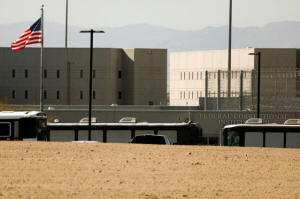|
Lawyers, workers question putting
immigration detainees in U.S. prisons
 Send a link to a friend
Send a link to a friend
 [June 09, 2018]
By Sarah N. Lynch and Kristina Cooke [June 09, 2018]
By Sarah N. Lynch and Kristina Cooke
WASHINGTON/SAN FRANCISCO (Reuters) - The
Trump administration's transfer of hundreds of detained immigrants into
five U.S. prisons puts the detainees and prison staffers at risk, said
prison workers and immigration lawyers on Friday.
Prison staff, accustomed to dealing with convicted criminals, may lack
training to deal with detained immigrants who may be unable to get the
legal, medical and translation resources they need while in prison, said
lawyers and prison workers.
"The last thing the government should be doing is putting immigrants
into prisons so that it can detain even more people who pose no threat
to anyone," said Omar Jadwat, director of the Immigrants' Rights Project
of the American Civil Liberties Union, a civil rights activist group.
Reuters reported on Thursday that U.S. Immigration and Customs
Enforcement (ICE) has entered into a 120-day agreement with the Federal
Bureau of Prisons (BOP) and the U.S. Marshals Service to house up to
about 1,600 people awaiting immigration hearings or deportation in
prisons.

The move came after ICE ran out of space to accommodate detainees
following the Trump administration's introduction of a zero-tolerance
policy on illegal immigration. The policy includes separating migrant
women and children, prosecuting every illegal border crossing and making
it harder to win approval for asylum.
Officials from the Justice Department and ICE defended the arrangement,
saying it has been done before.
"ICE routinely makes use of BOP space. Coordination on this level is
another prime example of why Congress needs to act to provide the
administration with the resources," a Justice Department official said.
"ICE is confident in the safety and security of detainees held at these
locations," said Dani Bennett, a spokeswoman.
At Federal Detention Center SeaTac near Seattle, people who normally
work as electricians and plumbers are being deputized as corrections
officers to accommodate 209 new, mostly female detainees, said Raphael
Lee, a senior officer specialist and member of the American Federation
of Government Employees Council of Prisons.
"Right now in this institution, we do not have enough staff to currently
work the posts that are here," he told Reuters.
"There are plumbers, electricians, education teachers, nurses that come
in their scrubs...to work their jobs, and they are told you cannot work.
You have to go work a unit."
The federal Bureau of Prisons, part of the Justice Department, was hit
hard by Trump's government-wide hiring freeze in 2017. The bureau faces
further job cuts in the 2018 budget, including a decrease of more than
1,800 corrections officers, according to budget documents.
[to top of second column]
|

mmigration and Customs Enforcement (ICE) detainees arrive at FCI
Victorville federal prison in Victorville, California, U.S. June 8,
2018. REUTERS/Patrick T. Fallon

Federal prison employees are considered corrections officers and
undergo special law enforcement training, but when prisons run short
of staff, they sometimes follow a practice known as "augmentation"
to deputize managers, nurses, teachers or utility workers as
corrections officers.
The Victorville prison in California, also expected to rely on
"augmentation", will house 1,000 male detainees, according to John
Kostelnik, the local union president of the American Federation of
Government Works Council of Prisons.
To make space, the prison is opening nine empty housing units and
transferring about 500 inmates to a second facility. Kostelnik said
he was told the detainees will get "books and the bare minimum." He
said it was unclear how the prison will staff visiting hours or
provide translators for detainees in a timely fashion.
ICE "will provide translators, but we have to contact them every
time we need them and it is very costly," he said.
Lindsay Toczylowski, executive director of the Immigrant Defenders
Law Center, a firm that represents immigrants, said bringing 1,000
immigrants into a prison 85 miles northeast of Los Angeles would
strain legal resources.
"A new facility just coming online like this with an extra 1,000
people is really concerning, especially in a place that is not
equipped to deal with immigrant detainees," she said.

Jorge Baron, executive director for the Northwest Immigrant Rights
Project, said his organization has faced challenges trying to speak
with detainees being held at SeaTac.
Of the five women his organization had interviewed as of Thursday,
he said, all of them had been separated from their children and all
were seeking asylum. "People are being deprived of access to
information," he said.
(Reporting by Sarah N. Lynch in Washington and Kristina Cooke in San
Francisco; Editing by Kevin Drawbaugh and James Dalgleish)
[© 2018 Thomson Reuters. All rights
reserved.]
Copyright 2018 Reuters. All rights reserved. This material may not be published,
broadcast, rewritten or redistributed.
Thompson Reuters is solely responsible for this content. |